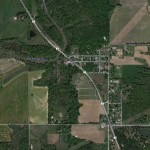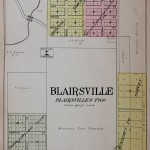Blairsville, a post office and village on the east bank of Big Muddy river in section 20 of Blairsville Township, marks one of the first points of settlement in the county. A good ford with gravel bottom enabled travelers to cross the river at most seasons of the year. Indians found the high river banks an  excellent site for camping, and spread up and down stream four or five miles. An Indian burial ground was uncovered in 1938 during grading for the new bridge.
excellent site for camping, and spread up and down stream four or five miles. An Indian burial ground was uncovered in 1938 during grading for the new bridge.
French traders came regularly to these Indian camps, to bargain for peltry. Their name for the river, Au Vase, was given to the brush shelter they built for a trading post. Tradition persists that George Rogers Clark crossed the river at this ford in 1778, but if he did he was not taking the most direct route to Kaskaskia.
Humphreys’ ford a few miles upstream was the first American settlement in the neighborhood. William Campbell, a son-in-law of the Revolutionary soldier at Russell corners, built a cabin at the site of Blairsville in 1823. But the Campbell family soon moved on to a new frontier, to Wisconsin.
Arrival of Stephen Blair about 1832 marks the real beginning of Blairsville as well as the giving of its
name. Mr. Blair built a watermill on the east bank of the river, a short distance upstream from the present bridge. People came to have their cornmeal ground, instead of merely to cross the river for more distant places. Wiley Blair joined his older brother, and they added a country store in their enterprise when the mill had caused a village to grow. The Blairs came from Posey County, Indiana where their native community of Blairsville celebrated its incorporation centennial July 4, 1937. Wiley Blair was peace officer and constable as well as miller. He moved to Herrin’s prairie and succeeded Will Pope as miller, while his daughter attended Chittyville School.
Folks coming to mill brought opportunity to other business men. John H. Mulkey and George W. Aiken opened a store at Blairsville in 1848. A few houses were built, and on April 28, 1850 a village plat was surveyed. John H. Mulkey began to practice law in 1856, moved to Cairo, and became judge of the circuit and supreme courts.
George W. Aiken stayed at Blairsville, and on April 26, 1856 his general store became the post office as well. Mail came by star route from Fredonia post office. A man rode over every Saturday to bring letters and papers for Blairsville residents. During the troubled times of the Civil war George W. Aiken became quartermaster of the 128th regiment, was discharged, and returned to lead the dreaded Aiken’s gang against unprotected farmhouses.
When the Blairs abandoned their mill, Ethan Allen Sprague took over the mill dam to make a fish trap. The Blairs had a contrivance for catching a few fish under the mill wheel, but Mr. Sprague went into the business on a professional basis. He cut out the logs from a short section of the dam, to make a spillway. A fence of poles surrounded the trap below the dam. When the river fell, fish came downriver and were caught in the trap until Mr. Sprague bailed them out and went peddling. Mr. Sprague was a Vermonter, proud of his Green Mountain ancestry, and an uncle of the young postmistress at Dago.
Blairsville ford was a fine bed of gravel when the first Americans knew it, the best ford of any along Big Muddy river. A long gradual slope approached from Six Mile prairie to the north, with a high ramp going out to Eight Mile prairie and the south. Heavy ox wagons cut into the east bank, the slope was sharpened, and going down to the ford took careful driving. The nickname “Pull-tight” was an admonition.
In time the river deposited a mud bank over the gravel bottom. The ford was cross-laid with poles, this rude paving held in place with stakes. This mud bridge was succeeded by iron bridges until the fine new highway bridge was constructed in 1938. Old tales of the river’s covering the west approach and washing the floor of the bridge can never be repeated.
See also, Pull Tight History
(Extracted from Pioneer Folks and Places, Barbara Barr Hubbs, 1939, on sale at the Williamson County Museum)

